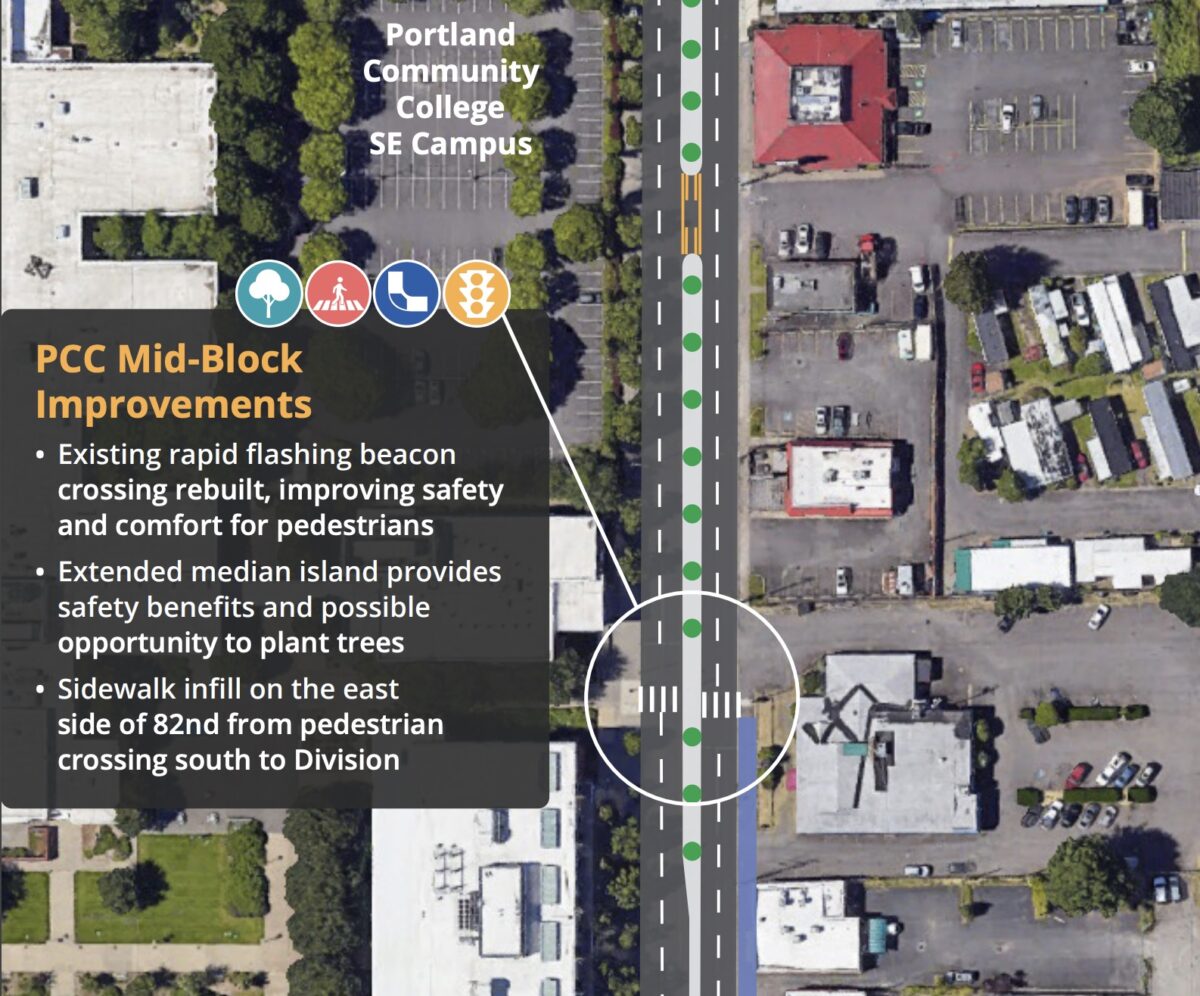
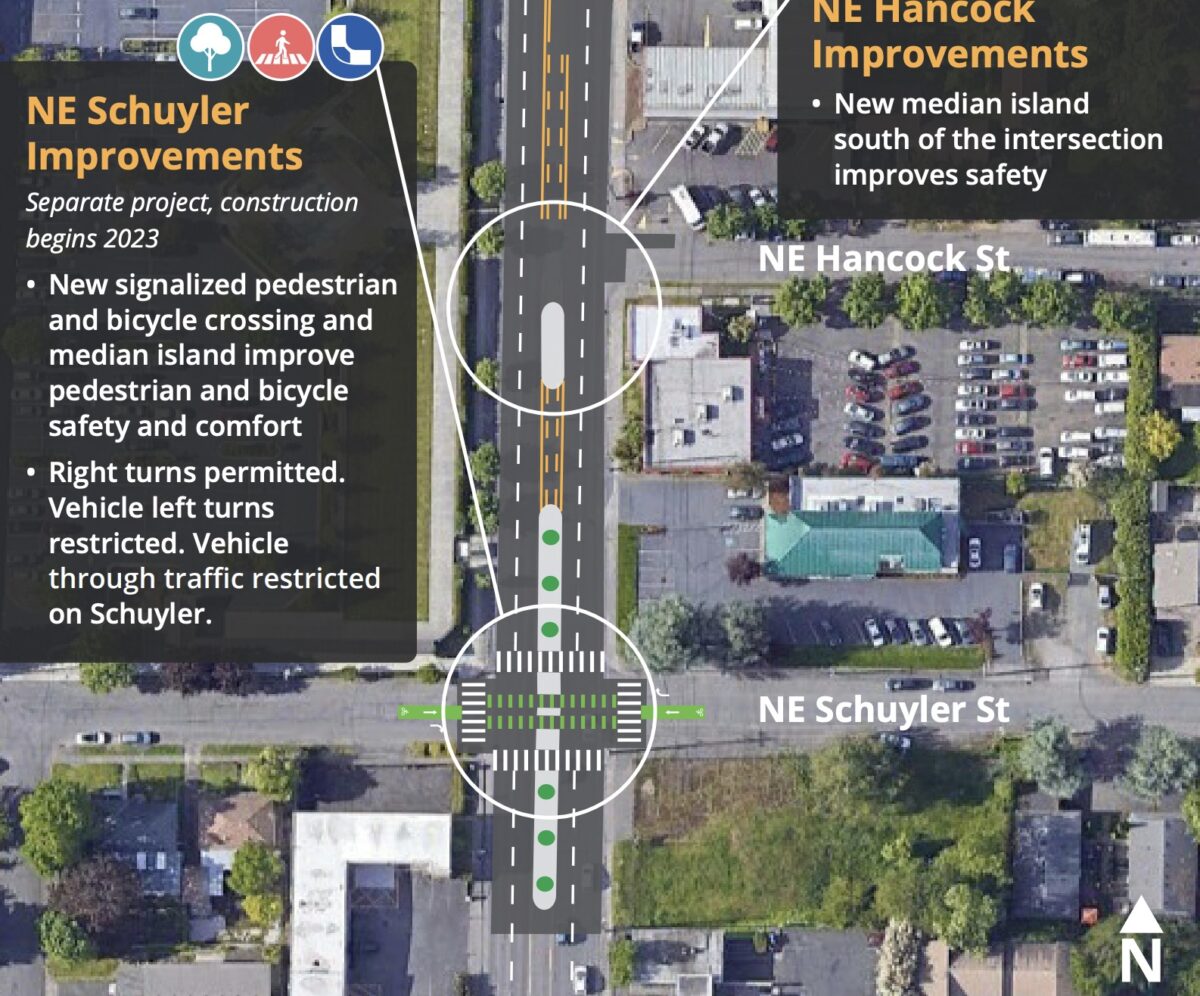
The City of Portland has released its first draft of changes they want to make to 82nd Avenue after the former state highway became their property last spring.
With $55 million in American Rescue Plan Act (ARPA) funds, the Portland Bureau of Transportation has begun design of key elements of their Critical Fixes: Major Maintenance Project on a 2.5 mile stretch of 82nd. The project will focus on “near-term critical safety and maintenance repairs” on two separate sections: from NE Fremont to NE Schuyler, and from SE Mill to SE Foster.
82nd will look a lot different once this project is completed. The draft calls for planting a lot of trees in concrete medians in the middle of 82nd Avenue.
PBOT laid out five goals for the project in a statement yesterday:
- Provide safe and comfortable places for people to cross 82nd Avenue by installing pedestrian signals, bike signals (at neighborhood greenways), and median islands
- Reduce the risk of serious injuries and fatalities for all people traveling by installing median islands in areas with a high crash history
- Mitigate the impact of extreme heat events by planting trees where possible
- Improve accessibility by installing ADA curb ramps for people using mobility devices, wheelchairs, and strollers
- Address maintenance needs through repaving, signal reconstruction, and updated street markings
As you can see in these images, PBOT does not show any bike or bus-only lanes — those will be considered in separate projects. Instead, this project is about helping people cross 82nd and taking initial steps to tame car drivers. While new types of uses aren’t yet on the table, PBOT does show a lot of small lane striping and operational changes (a.k.a. “access management”) for drivers at key intersections. At 82nd and NE Siskiyou, for instance, PBOT plans to remove right turn lanes on Siskiyou to “improve safety.”
Perhaps the most substantive piece of this draft concept are the median islands. PBOT has over 30 of them planned. These concrete islands will not only create shorter crossing distances for walkers, bike riders, and other users, they will also calm drivers by narrowing lanes, removing the center lane altogether, and limiting the types of turning movements people can make.
Some form of the word “restrict” in relation to driver turning movements, is used 19 times in the draft concept document.
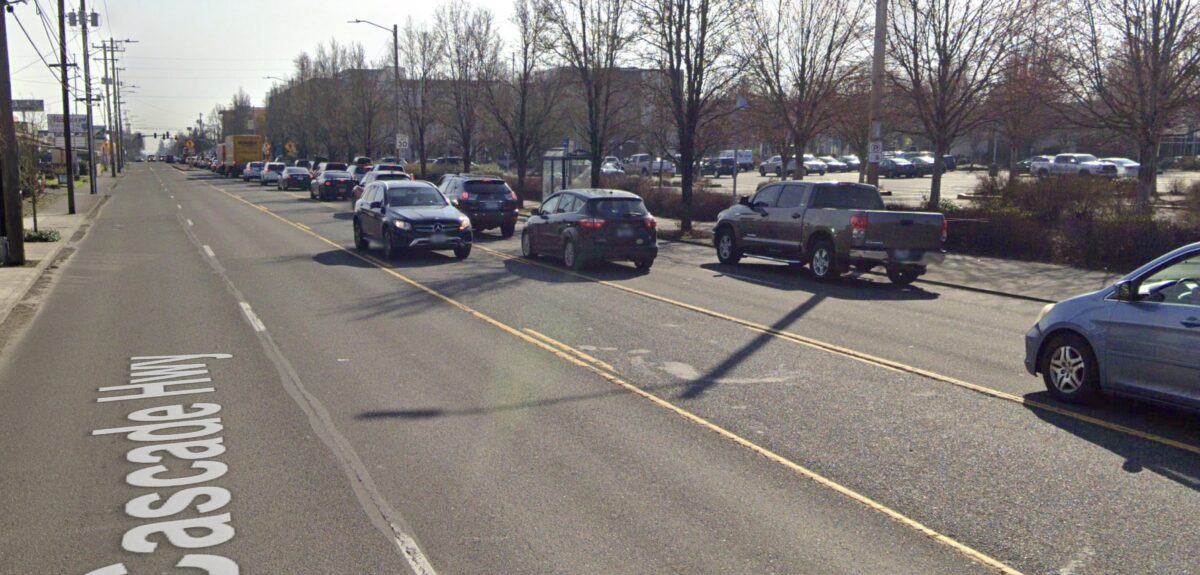
In one segment of the project, PBOT will install a nearly continuous median from SE Holgate all the way to just north of Powell. There will be a new center median outside Portland Community College between Division and Harrison that will include numerous street trees (dots on the concept map do not equal trees — PBOT says it’s too early to know exact number).
The focus on trees isn’t just for their traffic calming or aesthetic impacts. As we covered over the summer, the lack of shade in east Portland directly contributes to “heat island” effects and as hot summers become more common due to climate change, PBOT wants to construct cooler streets.
New and upgraded signals are another big-ticket item in this project. Those will also allow PBOT to facilitate safer crossings and more efficient traffic flow.
PBOT has also released a project survey targeted toward business owners along 82nd. One aspect of this project with the highest potential for pushback is how planned median islands impact the ability of drivers to access driveways along the street. Given all the bad headlines about this issue on the recently completed Division Transit Project, PBOT wants to get ahead of the issue on 82nd. An online open house is also in the works for mid-April.
One thing to keep in mind with this project is that PBOT already has many plans and years of public feedback for how to improve 82nd Avenue. So they are not starting from square one and we should expect the public outreach process to reflect that. It’s also early in their effort to turn 82nd into a thriving main street — this being just the first of many phases to come.
Design of the project has begun and will continue this year and PBOT expects to break ground in 2024. The changes should be completed by the end of 2026. Check out the full draft concept here (PDF).


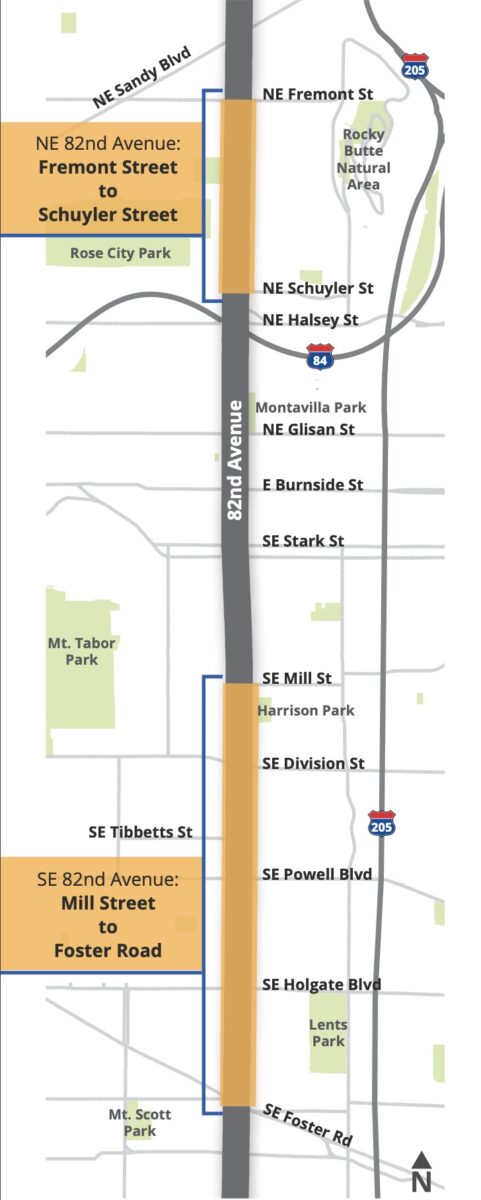
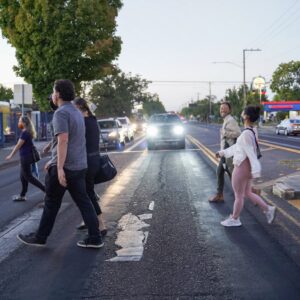
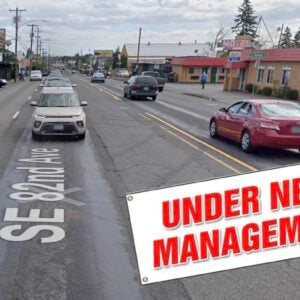


Thanks for reading.
BikePortland has served this community with independent community journalism since 2005. We rely on subscriptions from readers like you to survive. Your financial support is vital in keeping this valuable resource alive and well.
Please subscribe today to strengthen and expand our work.
Glad to see trees in a center median, shading the asphalt. I hope they have sturdy bollards or guardrails to protect them, so they don’t get mowed down by drivers, like so many on MLK have been. And, while there are some now, would be nice to fill in the missing trees along the sidewalk, where the shade will really be helpful to people, and not wait for each parcel to redevelop.
I’m all for trees but when they’re in the median, especially near crosswalks, it makes it more difficult to see pedestrians
Urban Forestry doesn’t allow trees within 25 feet of a crosswalk for that reason.
Can you show me where you found that for medians? It’s certainly not true for trees on sidewalks, according to Urban Forestry:
https://www.portland.gov/trees/documents/street-tree-planting-and-establishment-guidelines/download
The rule for sidewalk trees is “25 from CURB LINE of an intersection”. That means the entire crosswalk is within that 25′, so the actual clearance between the tree and crosswalk may be only 10′ or even less.
I regularly cross streets in crosswalks (marked and unmarked) where I can’t see oncoming traffic (and it can’t see me) unless I’m right at the curb edge, because I’m only a few feet from large street trees that are compliant with the 25′-to-curb clearance. It’s especially bad on streets like Macadam with traffic going 35-45 mph only 4′ in front of me and my dog at the curb.
Huh, I must have misremembered. I thought it was 25 feet from the crosswalk, which would make more sense. In any case, PBOT would be the decider for medians, not Urban Forestry, and hopefully they will set them back further from the intersections.
This is my first thought, too. “Better barricade the hell out of these trees if they think they’re ever gonna reach a mature age”. Barricade from cars and maniacs that want to mangle/cut them down.
Also makes me think of MLK Jr. Blvd. I like the trees along that corridor for aesthetic reasons but don’t like how they limit the visibility (when I’m driving) of people walking and biking across. Speeds still get pretty high on MLK. I’m thinking more particularly of the area between NE Fremont and NE Alberta.
I took the survey and referenced MLK between approx. Hancock and Killingsworth as what I’d like to see 82nd become. Lots of trees, some canopies covering the whole street, and yes please to more street trees. Too many giant asphalt car lots. Also, having more physical barriers/separation in the middle of the street would help calm things down a lot near intersections and crosswalks.
Worth noting that the medians shown here on 82nd Ave appear to be very wide, like 10 feet or so taking up the whole center lane. The ones on MLK with the small trees that get hit and damaged all the time are more like 4 to 6 foot medians. I think these ones will be more like the wider medians on MLK, which have nice big mature trees. Space is everything for a tree.
PBOT has already reported several times that double-lanes are deadly for pedestrians. If outer Powell can handle heavy traffic on one lane each way, why can’t 82nd? The excess traffic an go use nearby parallel streets like I-205 – add the bike/bus lanes already!
It’s distressing that PBOT apparently believes transforming 82nd to an MLK-like stroad is progress. MLK is one of the worst streets to cross as a pedestrian because planted trees make people walking virtually invisible at medians.
Can you see the pedestrian crossing in this image of MLK?
https://www.google.com/maps/place/NE+Alberta+St+%26+NE+Martin+Luther+King+Jr+Blvd,+Portland,+OR+97211/@45.5523674,-122.6615229,3a,75y,10.61h,92.69t/data=!3m6!1e1!3m4!1s1qY8V_–2QmslZ5stQTQSQ!2e0!7i16384!8i8192!4m6!3m5!1s0x5495a71a009e8947:0x257905d0a05f8198!8m2!3d45.5591224!4d-122.6614377!16s%2Fg%2F11hb7t2tdg
Not sure this is the best example. It’s not the trees that are blocking the view it’s the low quality image and vehicles. Also this is almost 400 feet away. Is there even a pedestrian there? When I zoom forward the southbound cars don’t appear to be stopped and that northbound car doesn’t stop at all. Finally if you go forward the trees are setback far enough that you can see the entire intersection from about 90 feet away.
I do agree that the double lanes are a bad idea. My guess is that PBOT knows that’s a non-starter so baby steps. That second lane can become a dedicated bus lane in the future.
Because a little red paint and some bus only lane stencils are beyond the scope of this $110,000,000 project?
No because removing two travel lanes and a middle lane would be a non-starter. Do you really think after getting chewed out by the business community in multiple public hearings our current council would approve or fund a plan like that? PBOT can’t just do whatever they want and our council is very pro-business.
Not to mention the political backlash. Without a doubt part of the reason Hardesty lost was because of the changes to Division. Never mind the fact that the whole council approved the funding for it and it was designed before she took over PBOT. A large number of voters aren’t very rational, informed or forgiving.
Bus lanes are being considered, but as Jonathan notes in the article they are being considered through a separate process with Metro, TriMet, PBOT, ODOT, and Clackamas all collaborating since that would be a BRT line crossing multiple jurisdictions. I agree that bus lanes along the whole corridor is probably politically difficult.
**$185 million https://www.portland.gov/transportation/planning/82nd-avenue/building-better-82nd-avenue-online-open-house/1-welcome-82nd
If PBOT is unwilling to put bus lanes on the busiest part of the busiest bus in the city, they will not be willing to put bus lanes anywhere – which makes it seem like maybe they don’t actually value public transit over private automobiles (despite what they say).
Waiting for “the future” just means it won’t ever happen – they have $110 million now. Who is it a non-starter for? Certainly not the thousands of Portlanders who rely on the 72 every day
If you look at most of the Rose Lanes (maybe all of them?) that PBOT has put in, they are where multiple bus lines converge, resulting in very high ridership and frequency. Burnside Bridge, Couch, Madison, Morrison, Hawthorne, Capitol Hwy, Grand/MLK…all of them have buses every 5 minutes or so. 82nd Ave only has a bus every 12 minutes. So I’m not sure it’s really as good a candidate for bus lanes as you’re making it out to be. You don’t want a bus lane to be sitting empty most of the time, do you?
I’d rather a bus not be sitting in traffic.
Installation of a rose lane on 82nd should be paired with more frequent headways (and 24 hr service).
Yes! If PBOT is going to give them Rose Lanes then TriMet should step up and provide more service. 12 minutes is not really frequent, despite the way they like to say anything 15 minutes or better is frequent. You still have to check a schedule, and worry about missing a bus and waiting for the next one. It seems like buses need to come every 5 minutes, or so to be able to relax and not worry about the schedule.
+1000 points
Bus lanes allow for massively better bus service that costs TriMet less money – since they can maintain headways with fewer total vehicles. The bus immediately becomes much more attractive of an option when the schedule is more reliable. Just compare the non-rush hour schedule of a bus to the rush hour schedule – the 72 runs 29 minutes slower during peak times (92 minutes vs. 63). A bus lane can’t solve all that, but combined with all door boarding almost all that difference could be made up. 25% faster bus service is massive – there is no transportation project anywhere in the city that can offer that kind of gain relative to the cost
Sure, it’s “sitting empty” – it offers the bus, and bus riders a low traffic option on a busy corridor. That is the point. All lanes are empty “most of the time” if you control for the actual number of people traveling rather than vehicular flow. Sure, maybe a car goes by every second on average during peak times – but consider how much space is wasted on just their car. And the space between cars. And on extra space in the lane. If you want efficient flow in terms of people moved/hour, start with a wide sidewalk and go from there. Spend 1 day in New York City walking around and you’ll find traffic flows orders of magnitudes higher on sidewalks.
I’ve attended several of the 82nd coalition meetings and I can tell you interest is high – from all parties – in HSRT lanes on 82nd. Line 72 is the busiest in the system AND experiences the most delays, so all parties involved know that transit prioritized lanes similar to Division are a strong consideration. But that’s not part of this round.
Not to mention it destroyed local Black owned business and basically made MLK a complete car street .
Another great idea…..
They just removed a tree planter on 7th.
Yes, the median and other 70s changes to MLK destroyed it as the commercial heart of the black community. (Vancouver/Williams was also destroyed.) Every change was aimed at improving the drive between Portland and Vancouver without concern for the people who lived, worked and shopped in N/NE.
I was involved in a project in the 90s to try to undo some of that damage. We added crosswalks, on-street parking, and better sidewalks. The real key was removing large sections of the median. More would have been better.
That’s my concern when I see “median” in any project. Medians are used to speed up traffic by eliminating mid-block turns, and sometimes run through intersections to eliminate intersection turns and cross traffic, and even pedestrian crossings.
Macadam is another treed median street. I like the trees, but its main purpose–as with MLK–is to facilitate more and faster traffic. It blocks pedestrian crossings at several intersections, and creates more traffic on neighborhood streets due to blocking direct turns.
And yet, Macadam is not a high crash corridor, and even though MLK is a high crash corridor it has a much lower crash rate and far fewer deadly crashes than 82nd Ave. Medians are a proven safety measure, especially for pedestrians but really for all traffic.
I’m also very skeptical that the medians were the primary cause of damage to the MLK business community. Correlation does not equal causation. There were other forces at work.
I will grant you that the original ODOT median project was probably done more to improve traffic flow than to improve safety, and probably wasn’t designed with enough openings, and that the later PBOT project was an improvement. Hopefully they can get it right the first time on 82nd Ave by considering business impacts, being responsive to public concerns, and by focusing on safety rather than traffic flow.
“I’m also very skeptical that the medians were the primary cause of damage to the MLK business community. Correlation does not equal causation. There were other forces at work.”
I don’t think they were (which is why I wrote “the median and other 70s changes”). MLK businesses were already facing challenges before that project. But adding the median removed on-street parking, sped up traffic, eliminated turns into businesses (mid-block and at intersections), eliminated crosswalks, etc.–all devastating to already-stressed businesses.
Medians CAN improve safety, but on both MLK and Macadam that’s done by eliminating left turns; eliminating crosswalks at intersections; blocking neighborhood circulation for vehicles, pedestrians and bikes by blocking cross-traffic at intersections–not necessarily the best ways to achieve safety by any means.
I agree that medians on 82nd could be beneficial for safety if done correctly.
Agreed! The space is much better allocated to the sidewalks where the space between the trees can be sued for seating, retail, etc. Getting rid of the median AND widening sidewalks also makes the street easier to cross and creates a better physical and visual connection to both sides of the street. The street becomes a place and the road less of a barrier. For 82nd, widened sidewalks would be amazing for future and re-development, but if would mean losing a left turn lane in spots and causing traffic delays. I doubt PBOT is willing to sacrifice level of service for safety
Part of the intention of the medians in the next (current) phase on 82nd is to limit left turns and cars using the center lane, and to create safer crossings for pedestrians and cyclists. Many of the crossings are also getting RRFB’s, something 82nd desperately needs. The design is definitely NOT intended to smooth or speed up car traffic.
Your use of “stroad” seems inappropriate in this context. A classic “stroad” looks like 82nd Ave–a busy road with lots of commercial businesses that is just a big wide expanse of asphalt. MLK with the median is more like a “boulevard” and is often how a stroad is turned into a more livable street.
With all due respect, describing a traffic sewer like MLK as a “boulevard” is absurd.
I think MLK is one of the nicest four-lane roads in the city. Yes, it would be even nicer if it didn’t have four lanes, but I don’t agree it is a “traffic sewer” by any stretch. The trees are very lovely, providing a great canopy, the sidewalks are nice and wide, there are nice streetlights, lots of signals and crossings, etc. As always, I suppose these things are very subjective.
Meanwhile we have Burnside, a street that might as well be called a boulevard that’s also actually a traffic sewer!
Think about MLK from the point of view of a pedestrian or a person in a wheelchair — from the point of view of someone who actually lives in the neighborhood and wants to cross it without traveling 800 feet to the nearest marked crosswalk (why the @#% are their marked crosswalks without signals on such a dangerous street).
Outer Powell is able to narrow because Outer Division is there to pick up the slack. 82nd Ave doesn’t really have an alternative. I-205 is not a good alternative since I’m guessing most drivers on 82nd Ave actually have a destination on 82nd Ave. It’s not like you can use 82nd Ave to get to Vancouver. They serve very different purposes.
Let me guess. Zero plans for traffic enforcement?
There are automated speed cameras coming to 82nd Ave.
Not crazy about this plan. There is no way that PBOT can have a full concrete/tree median, bus lanes, bike lanes, and wider sidewalks. They are painting themselves into a corner by doing this, or they are content to not actually change very much on 82nd. I have no doubt that they’ll (in conjunction with TriMet and Metro) nix the bus lanes, provide minimal “upgrades”, call it an FX service and then check a box – all while doing functionally nothing (outside maybe signal priority) to improve transit service on the busiest bus route in the city.
There’s not enough room for those things anyway, the median has nothing to do with it. You need turn pockets at all the major intersections, so repurposing the center turn lane would not actually accomplish anything. Unless you want bike lanes that start a block past a major intersection and then end a block before the next major intersection…
My preferred design would be prioritizing bus lanes + wider sidewalks with trees nearer the curb rather than in the center. Removing the center lane outside intersections, having a general travel lane and a bus lane each way, with the space saved from the median going all to sidewalks/trees. There would still be room near major intersections for a pocket turn lane (by narrowing the sidewalk). Or a center-running BRT, but I’m not holding my breath on that one.
It’s a bummer that there probably isn’t room to get a safe bike lane in. But given that transit on 82nd is really important already, I’d be willing to concede a bike lane for better walking and transit conditions.
No plan for bike lanes on 82nd. It’s a matter of available real estate, as others have pointed out. Higher priorities (and this comes from the local community input as well as PBOT) is stopping the carnage and making room for pedestrians (many of the sidewalks on 82nd are not currently even ADA compliant, especially with phone poles in the sidewalk.) Next priority is improving transit. The improved crossings, including medians, are bike infrastructure to a degree. But I don’t think anyone is planning on using 82nd for a N/S bike route in the foreseeable future. It would be great if they could put in a combined pedestrian/bike multiuse sidewalk like along Moody in South Waterfront. But since nearly every business along 82nd has a parking lot with curb cuts, I think that kind of infrastructure isn’t under consideration.
82nd really needs protected bike lanes and bus priority lanes. Giving up a travel lane for a center lane median cuts into width that non-car centric road use could use.
There may be differences in the underground utilities, but I have very little faith that the trees in this plan will be included in the final build given what happened on Division.
Also it’s disappointing to see no improvements between Mill and Halsey.
There’s not enough room for those things anyway, the median has nothing to do with it. You need turn pockets at all the major intersections, so repurposing the center turn lane would not actually accomplish anything. Unless you want bike lanes that start a block past a major intersection and then end a block before the next major intersection…
I hope these designs are actually buildable. While it’s not survey-level-accurate, Portland Maps shows sewer pipes going down the middle of 82nd for significant intervals. That’s the reason that the changes PBOT made to Division don’t include trees (except for on one block).
Do sewers preclude the medians because they would make accessing the sewer for maintenance more difficult, or because because of concerns about tree roots?
Tree roots. Basically; they changed the minimum distance from tree to water/sewer main to 10’ in 2016, which meant thousands of properties could no longer have street trees planted in the “hell strip” between sidewalk and curb.
This regulation doesn’t take tree size or species into account, sadly, as many have roots that would never get half as far. And, you can plant anything you want, like a sequoia, in your front yard just a few feet further away…
It’s not just roots, it’s also the maintenance issue. BES and Water do not want to have to remove trees every time they need to dig down to do maintenance.
Also, the 10 feet is a preference, not a hard standard. I believe they will accept 5 feet in many cases.
Tree roots are not an issue if proper root barriers are used and the right species of tree planted.
Iain
What makes you such a good bird-dogger?
keep up the good work/observations
On Division, my recollection is that there was a major, shallow water line right down the center that precluded trees for most of the corridor. The sewer lines on 82nd Ave are occasionally down the center, but mostly they’re offset enough that trees should be fine. And sometimes sewer lines are deep enough that it’s not an issue. I’m guessing we will not get as many trees as are shown in this “concept” but that it will be a lot more trees than on Division.
I expect a lot of push-back on these changes fortunately most of them are in Khan Pham’s district who’s been a great advocate for improving safety along all of 82nd. Hopefully that will help sway enough of the business interests along the corridor that safety is more important than their customers convenience.
Still a tough sell for businesses mostly built to cater to drivers. I live in this district and rarely access anything along 82nd outside of a car. When I do it’s always an ordeal. It’s usually easier to go a bit further to a more bikable area. Something I’ll bring up when they ask for community input.
The plan you’re looking at isn’t a proposal awaiting public comments. We’ve already been through that part over the past year. This is the work that’s actually happening, and the local business community has been part of the process.
It’s curious how a so-called democracy would give business owners one vote as Portland residents and then a far greater vote as very serious and very important “biznis” owners.
Business owners didn’t get any preferential treatment or extra votes. But they did care enough to attend the 82nd Coalition meetings – which were open to all. Did you attend? Or do you prefer to armchair quarterback?
I cannot imagine cycling on 82nd. I ride to Home Depot sometimes on the Springwater trail and then south on the 205 path so I know the neighborhood. 82nd is very tight for ROW so the whole wish list won’t fit. There are LOTS of driveways that increase the risk of right hook collisions and 82nd is a cruise and car parade route for drivers who dislike cyclists. (Roll’n coal anyone?). Fix 82nd for pedestrians and heat island effect and route cyclists to the 92nd bike lane, or the 205 path (after removing campers there)
I agree. We shouldn’t even think of trying to put bikes on 82nd. There’s no room. But there’s a workable parallel bicycle route using 78th/79th/80th from Flavel to Halsey. (Sadly, you need to jog over to 74th/ 72nd to continue north to Killingsworth.)
Every city road should be made safe for cyclists. The busier the street, the more protective the treatment should be. Requiring cyclist to got 10s of blocks out of their way to move north/south along the 82nd corridor is a joke and failure by PBOT.
The 70s bikeway is two to three blocks away for most of the length, and the 80s bikeway is about five blocks away.
And 82nd is 0 blocks away
Insisting on bike lanes for 82nd means you probably won’t be part of the actual discussions taking place. In a perfect world with unlimited real estate and unlimited money to buy easements from the property owners along 82nd, a bike lane might be possible. But in the world we actually live in, adding a bike lane means you either eliminate cars, pedestrians, or transit – take your pick. The local community has already voiced their opinion and the current plan reflects it to a large degree.
82nd is a major arterial for N/S traffic AND one of the busiest bus corridors in the region AND needs more space for pedestrians. I advocate putting bikeways everywhere there is room for them. But there’s no room for a protected bikeway on 82nd unless you get rid of either cars or the prospect of a busway, or put bikes on already-too-narrow sidewalks. Getting rid of cars is a non-starter, I want to see an FX bus line on 82nd, and riding on sidewalks is a recipe for bike/pedestrian collisions.
So we need improvements to parallel bikeways instead.
Sadly the new 70s greenway will jog west at Everett, south of Glisan, and then cross at 78th and slowly jog over to cross Halsey at 76th and then to the 74th/84 crossing. Less convenient for businesses on 82nd, Montavilla Park, and the Mac station/transit center.
I completely agree, I was very disappointed by that unexpected change in the route, which was supposed to be on 80th Ave all the way from Burnside to Halsey. They moved it to 78th/76th out of convenience, to use an existing crossing at Glisan rather than add a new one at 80th. PBOT should strongly consider adding a bike route on 80th in that area as part of this 82nd Ave project.
YES! In several of the past plans for the 70s bikeway, they show the bikeway going on 80th all the way to Halsey, which just made SO MUCH SENSE to have it maintain a consistent distance to 82nd! A couple old plans also showed a new crossing at 80th. One mentioned a refuge island, RRFB, & ADA ramps. I’d trade the reroute for an added island, Glisan needs more to slow down traffic racing from 82nd.
I emailed the PM, Winston Sandino, and he said: “No it was not about the budget. We just looked at the safer option for crossing. Due to heavier traffic on 80th/Glisan we chose 78th as a safer crossing. Some bikers could continue going on 80th if they feel comfortable but we wanted to route bikes through more local streets.”
Feel free to contact him!
There is a funded project that will improve the entire 70s/80s bikeway over the next couple years. That should provide good access to 82nd Ave in combination with east-west routes.
Why not get rid of the unsignalized lefts, run a continuous 8′ median with trees, and run contraflow bus lanes in the center lanes? Could speed up busses considerably, improve canopy, and eliminate dodgy lefts.
I’m trying to picture this. Would this mean pedestrians would have to access the busses from the median? And busses would have to have doors on the left side instead of right side?